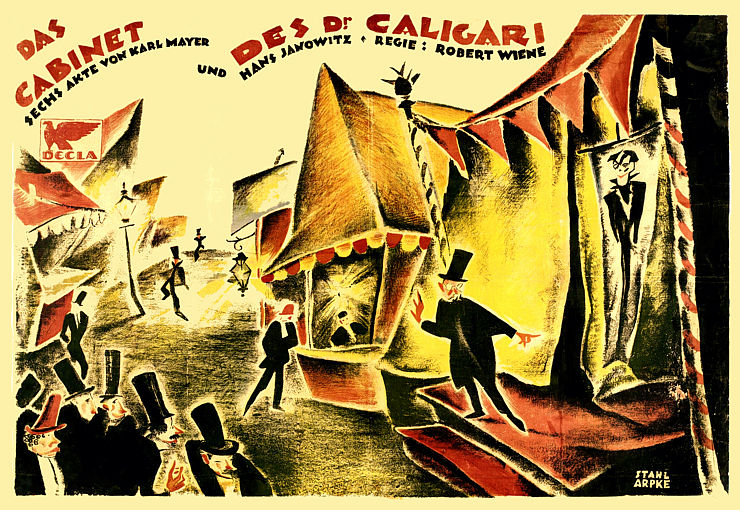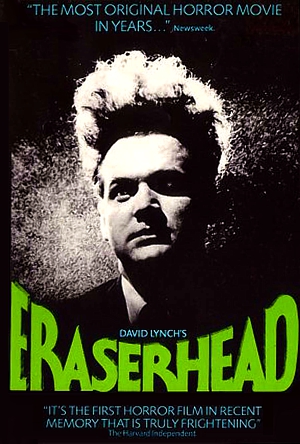 |
 |
Review by E.C. McMullen Jr. |

THE CABINET OF DR. CALIGARI- 1919USA Release: April 3, 1921 Decla-Bioscop AG, Rothafel, Goldwyn Distributing Company Rating: USA: N/A |
||
THE CABINET OF DR. CALIGARI is considered cinema's first Horror feature film and is considered one of the most influential movies ever made.
So its 2025. Feo Amante's Horror Thriller has been around since 1997. Why did I take so long to review it here?
Because it looked like crap!
Previous releases were difficult to see, decrepit, and so damaged that no complete originals were thought to exist. It took a long time and no small amount of money to find the best prints and then meticulously restore them, but here we are and here is my review.
Two men, one old, one young, are sitting on a bench. The old man speaks of his anxieties and the more he does, the more haunted and frightened he looks. Re-opening old wounds is having a terrible effect on him.
Just then, a young woman, her eyes rolled up and nearly all white, passes by. The young man is Franzis (Played by actor and director, Friedrich Feher) and he tells the old man that the woman's name is Jane (Lil Dagover: SPIRITISMUS, Fritz Lang's DER MÜD TOD, THE CHRONICLES OF THE GRAY HOUSE). She's his fiance and they've suffered an ordeal much worse than the "Spirits" that have driven the Old Man (Hans Lanser-Ludolff: THE HEAD OF JANUS, F.W. Murnau's NOSFERATU) from "hearth and home, wife and child."
"What she and I have lived through, is stranger still than what you have lived through. I will tell you about it."
So begins Franzis' horrific tale.
The entirety of reality in Franzis' telling appears hand-drawn and hand painted. Only the people, their clothing, and their beds look real. Franzis is describing his birthplace and hometown of Holstenwall in simple broad strokes, as a child would read from a children's book.
As Franzis rebuilds the memory of his town, the Old Man starts to nod off. Franzis, however, cannot stop. He remembers "Him", and the first living person to enter his tale is Dr. Caligari (Werner Kraus: THE DANCE OF DEATH, SPIRITISMUS, WAXWORKS), coming to Franzis' village during the time of their annual Fair.
Unlike all the other town folk, Dr. Caligari is somewhere between being a real person and hand drawn. Black lines define his features, his hair looks more wig than real, and his eyeglasses magnify and distort his eyes. Throughout his many close-ups its like you can never get a clear picture of him.
Franzis speaks of his friend Alan (Hans Heinz v. Twardowski: EERIE TALES, GENUINE: THE TRAGEDY OF A VAMPIRE, FROM MORNING TO MIDNIGHT), who is the more outgoing of the two men and invited Franzis to go to the fair with him.
TRIVIA 1 In his day, actor Conrad Veidt was a dashing and intimidating actor of such repute that even in Hollywood, he became one of the highest paid. What's more, while Conrad didn't set out to be a "Villain", he preferred to gravitate to Horror movies. including making his Directorial debut with WAHNSINN, which he also starred in. His most influential roles include his physical appearance as the nightmarish Cesare in THE CABINET OF DR. CALIGARE (his personal favorite) and Gwynplaine in THE MAN WHO LAUGHS. His appearance in this movie inspired the co-creator of BATMAN, Bob Kane, to model The Joker's appearance after Veidt's Gwynplaine. Both Cesare and Gwynplaine are considered examples of "Tragic" Monsters. In this case, innocent people "Cursed" by a disease that makes them appear frightening. The Nazi Party had all Jewish people's names removed from their films. That included the Producers of this movie. Eric Pommer, a Jewish war hero of Germany in World War I (he was awarded the Iron Cross), escaped in 1933. His Producer partner, Rudolf Meinert (1882-1943), was arrested and later murdered in the Majdanek Concentration Camp of Lublin, Lubelskie, Poland. |
Among the many attractions is a man named Dr. Caligari. His show is that he "owns" a living human being, a young man named Cesare (Conrad Veidt: EERIE TALES, SATANAS, WAHNSINN, DER GRAF VON CAGLIOSTRO, NACHTGESTALTEN, THE HEAD OF JANUS, MORITURUS, THE HANDS OF ORLAC, WAXWORKS, THE LAST PERFORMANCE, F.P.1. DOESN'T ANSWER, THE MAN WHO LAUGHS) who is afflicted with Somnambulism1.
Like Dr. Caligari, Cesare is not quite human and nearly hand drawn, as black lines also define his face. Unlike Dr. Caligari, Cesare's features are all too vividly detailed in close-ups in a way that has haunted many a viewer's nightmares.
Caligari's Somnambulist has slept through his whole life. Part of the affliction is sleepwalking and talking in one's sleep (as well as eating in his sleep. Caligari must sit Cesare up and spoon feed him. Who knows what Calgari must go through when Cesare pees and poops?). According to Dr. Caligari, Cesare's affliction allows him to straddle the border between all worlds and you can ask him anything you like.
"Cesare knows every secret. Cesare knows the past and can see into the future. Come up and test him for yourselves."
The audience draw for this sideshow is enormous and everyone gathers in the tent, ready to be amazed. However, they are taken aback by the towering, young man who sleeps in Dr. Caligari's "Cabinet", in what is essentially a coffin.
When the Somnambulist's eyes open, they stare out at nothing in Horror.
While everyone waits for someone else to be the first to question Cesare, Alan boldly steps up and, as a gag, asks how long he will live. Alan is stilled when Cesare promptly replies, "You have until tomorrow's dawn."
Alan tries to put on a good face in front of his town folk but he's obviously ruffled. Franzis quickly hustles him out of there and they both run into Jane, who is also enjoying the Fair.
Later, as Franzis walks Alan to his apartment, he admits that he knows they both love Jane, but whoever she chooses, that won't ruin their friendship.
Sure enough, Alan is murdered in the night though not, unfortunately, in his sleep. He's awake to die in fear and suffering while he's repeatedly stabbed to death.
The next day Franzis gets the bad news from Alan's landlady. After verifying for himself at Alan's bedside, he makes his way to the Police station in a daze of shock and grief to file a report of the crime.
It was murder, but not theft. Alan was killed for no apparent reason at all.
Soon there's another murder in the sleepy little hamlet. Again this is murder only, no theft. This is unheard of in a place where everyone knows each other and generally gets along with everyone else.
With the whole village tense and ready to jump at shadows, a man nearly kills a woman in her home, but her watchful neighbors catch him in the act, chase him down, disarm and capture him. They drag him off to the police.
Everybody wants to believe that this stranger in their town is the killer, but he admits to only trying to kill the one woman out of a personal grudge. He's guilty, but he's not the madman.
This returns Franzis' attention back to whom he's suspected all along: Dr. Caligari.
But why?
Movie critic Roger Ebert called this movie "The first true Horror movie", but of course that opinion is up for debate. In Germany alone there were at least four other Horror movies made in 1919, which starred Conrad. What's more, Germany also produced 1917's FURCHT, which also starred Veidt.
That said, it was THE CABINET OF DR. CALIGARI that got world-wide distribution, brought Conrad International fame, and by scaring the bejeezus out of the largest audience, added "Horror" to a genre of movies
But why was THE CABINET OF DR. CALIGARI labeled the first Horror movie if it wasn't the... first Horror movie?
The world was still stinging from Germany's first attempt to wage war against earth and most German feature films couldn't find their way out of der Fadderland, let alone Europe. And as for across the pond in the U.S.A.? Forget about it!
Now you may have noticed that I've made no direct mention of the style of cartoonish hand drawn and hand painted sets, which is German Expressionist.
This is why...
Because every time someone writes anything about this movie they harp incessantly about Art Director Hermann Warm's use of German Expressionism. Do a search on this movie title and you'll find no dearth of people nattering on about German Expressionism. Some of the articles are even thought provoking, but most of them are tediously referential in quoting what someone else already said or wrote.

I mean, Come on! There's so much more to this movie! So I'm talking about what gets less attention but I feel is no less important.
Writer and Director Robert Weine (DAS WANDERNDE LICHT, FURCHT, SATANAS, GENUINE: THE TRAGEDY OF A VAMPIRE, THE HANDS OF ORLAC, DER ANDERE) was used to working with Conrad Veidt and nearly every time they did, it was a Horror movie and every time it was a hit.
THE CABINET OF DR. CALIGARI was Writers Carl Mayer (GENUINE: THE TRAGEDY OF THE VAMPIRE, THE HAUNTED CASTLE) and Hans Janowitz (THE HEAD OF JANUS) first and last screenplay they wrote together: both of them based the story and characters upon their personal life experiences. Neither expected it to be such a smash hit. Neither also expected the movie company to use such cheap cartoonish looking sets. Expressionist? What is this artsy-fartsy crap, anyway?
Worse! Instead of just telling Mayer and Janowitz story, Weine added the frame of Franzis sitting on the bench with the old man to lead in and out of the story. Feeling their artistic principles were at stake, both were ready to stand on said principle and go to the press, impugning the movie.
They were persuaded not to. That's all I've found regarding why the writers decided not to publicly trash the movie. They were "persuaded" not to.
For me that one word is pregnant with meaning. Anyway -
I've mentioned in other reviews how often Cinematographers, Production Designers, Art Directors, and SFX artists can tell an entire extra story, sometimes even a different story, from the one the director is telling and that certainly applies here.
Hermann Warm was dealing with a low budget, but within that constraint, he was free to paint and draw all of the detail, light, and shadow he wanted to the production. From the sky to the ground to the walls, chairs, every inanimate object. Director Robert Weine felt confined by the low budget and Post WWI Germany's electricity rationing of the time (which for one thing, affected the amount of light they could use and how long they could use it). Warm felt somehow liberated by it.
Like most old movies and particularly silent films, they were all shot with a Cinematographer and director who came at everything with a stage director's view. It would be over 40 years before Stephen Speilberg's unique view of making movies caused Alfred Hitchcock to announce to his contemporaries, "He is the first among us who doesn't see the proscenium."
Because of this, for new audiences unaccustomed to silent movies, the actor's body movements are physically exaggerated. The actors, used to being nothing more than small slivers on the stage to the rows at the back, had to be flamboyant in their movements.
You watch enough of these old movies though, and just like learning the style of stop-motion models, Anime, and cgi animation, you become accustomed to the form and believe the movie.
Remember when watching this movie unfold, and all of the things you recognize, that here is where it was done first. THE CABINET OF DR. CALIGARI is, in all of the many best ways, the fundamental Ground Zero for cinema.
After over 100 years, THE CABINET OF DR. CALGARI may have its remakes and imitators, but it is unlikely that anyone will ever make such an original movie again.
Five Shriek Girls.





This review copyright 2025 E.C.McMullen Jr.

|
| DRESS NICE | |
| YOU MIGHT ALSO ENJOY (Sub-Section: OFF-BEAT) |
||
 |
 |
 |
| ERASERHEAD MOVIE REVIEW |
METROPOLIS MOVIE REVIEW |
DARK CITY MOVIE REVIEW |
For those who scroll...
The 2014 EUREKA release of the restored 4K THE CABINET OF DR. CALIGARI
And -
"The Cabinet of Dr. Caligari": The Making-of A Restoration
FEO AMANTE'S HORROR THRILLERCreated by:E.C.McMullen Jr. FOLLOW ME @ |
| Amazon |
| ECMJr |
| Feo Blog |
| IMDb |
| Stage32 |
| X |
| YouTube |
| Zazzle Shop |

